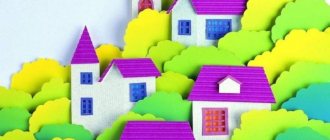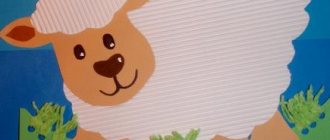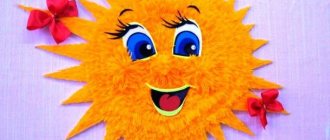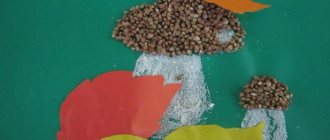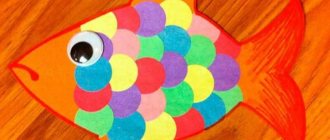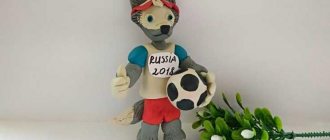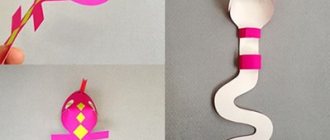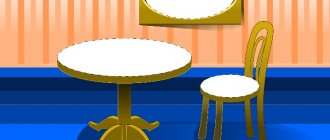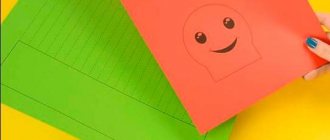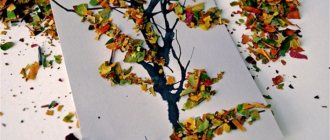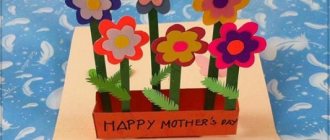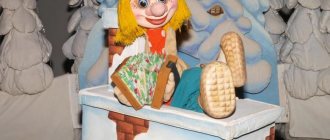Making crafts yourself is very useful for children, because it helps develop imagination and fine motor skills. Besides, spending time like this is always exciting and fun.
And to make spending time creating a beautiful, unique product even more interesting, connect with your baby - this way you both will get a lot of pleasant emotions and it won’t be boring.
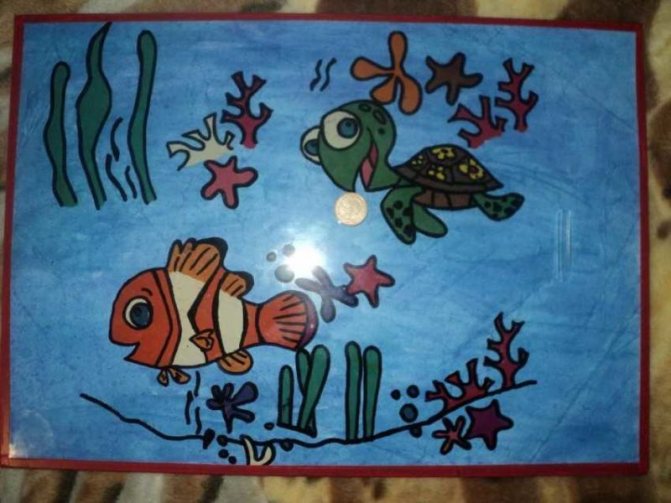
Materials for making fish applique
Before you start doing anything, it is important to find out what materials will be needed for the job.
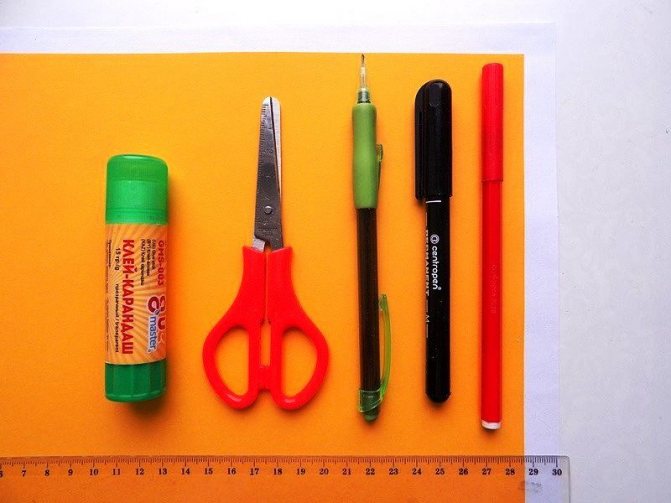
Most crafts are made from paper, so it will become one of the main materials. You will also need cardboard, plasticine and other things that you want to use in your applications (for example: leaves, seeds or buttons).
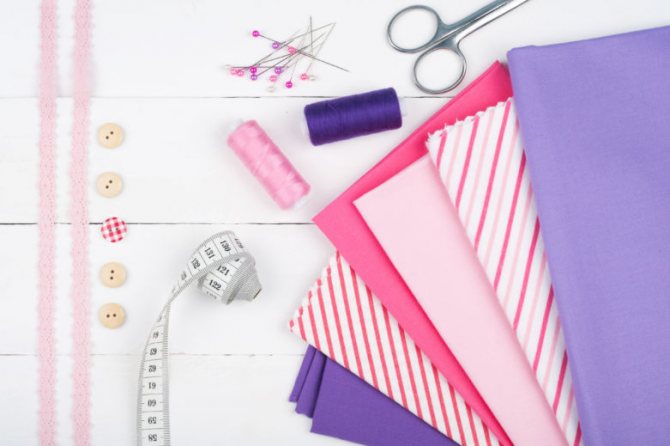
In addition, to create interesting figures, you will need:
- Scissors;
- PVA glue;
- Pencils;
- Markers.
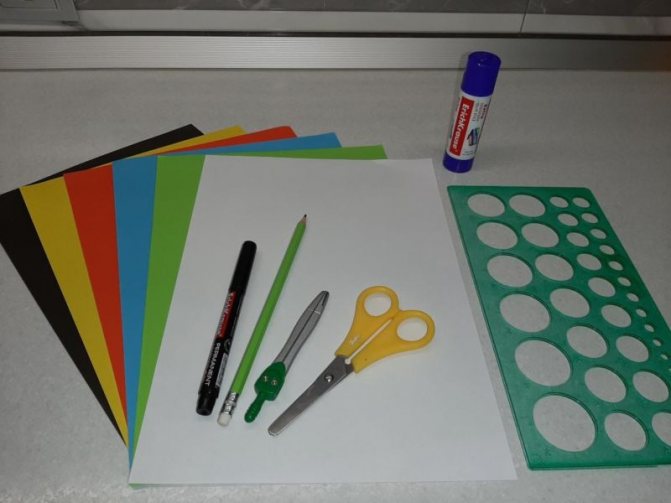
Undoubtedly, you should also stock up on patience, good imagination and a cheerful mood.
Paper
Children become familiar with this material even before kindergarten. Parents read fairy tales to their child, turning over the pages of a beautiful book. Teach the child how to use scissors correctly.
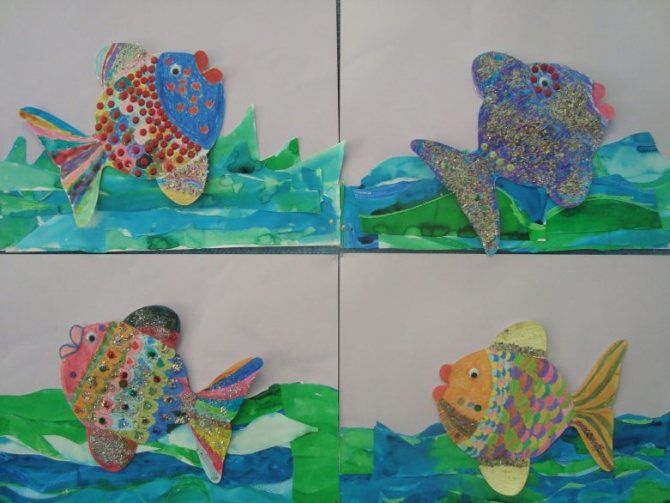
They color coloring books together. If you don’t have enough time to collect materials, the paper option is the most convenient. In preparatory groups, some children achieve impressive results by making appliqué from plain paper.
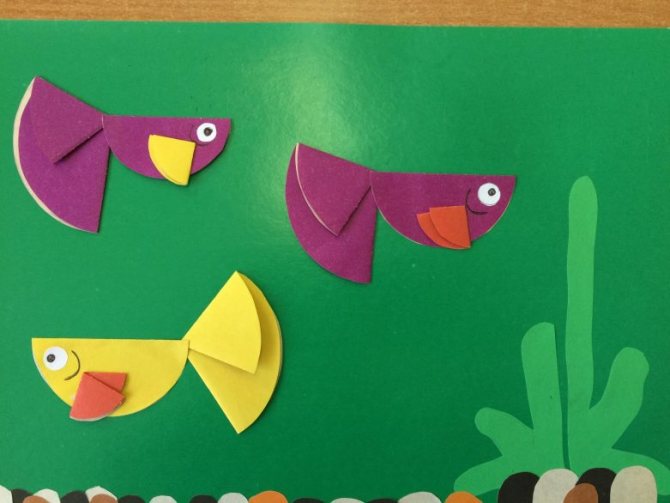
Note! Scientists studying the psychology of children (ages 1 to 6 years) say: paper cutting skills with scissors should be taught from the age of 1.5-2 years. In this way, concentration is developed, motor skills are trained, and logic develops.
Fish applique using templates
It is possible to create amazing fish using templates that can act as a stencil, or as a basis for appliqué. Such blanks can be made by simply drawing a silhouette on a sheet of colored paper, or by printing a ready-made picture found on the Internet.
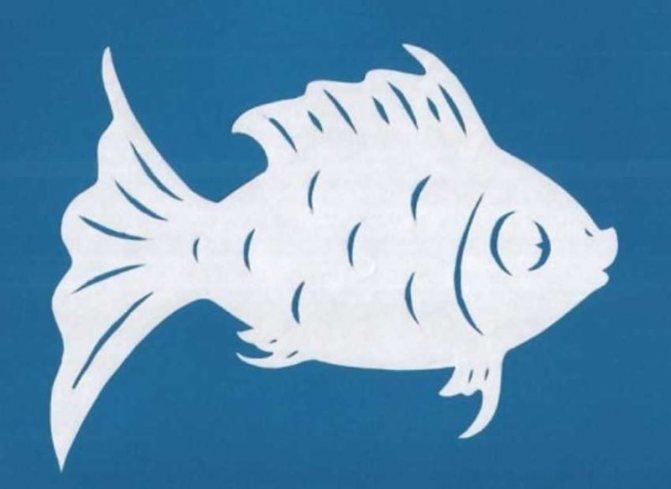
It's very easy and fun to use templates as a basis. The fish is cut out of a sheet, and then it can be decorated and decorated as you please.
Make a plan
No more than half an hour is allocated for the lesson.
Each stage of training is divided into several aspects:
- Motivational process - 5 minutes.
- Explanation of the main task - 3 minutes.
- Work with blanks - 10 minutes.
- Three minute break.
- Continuation of work activity - 5 minutes.
- Reflection - 5 minutes.
Geometric applique
This type of fish applique in an aquarium is perfect for kids, both younger and middle groups. During the creation process, they will not only have fun creating the product, but will also become familiar with a variety of shapes. Manufacturing consists of several steps:
- The first thing you need to do is find the right shades. The fish can be made in absolutely any color, and the background should be blue or blue.
- Four large circles are cut out of multi-colored paper for the bodies of the fish, four medium ones for the tails and a couple of small ones for the fins;
- Each circle is folded in half, and then any two semicircles of different colors are combined into one fish. After this, you can glue the remaining parts: tails and fins;
- Eyes and scales are drawn with a felt-tip pen.
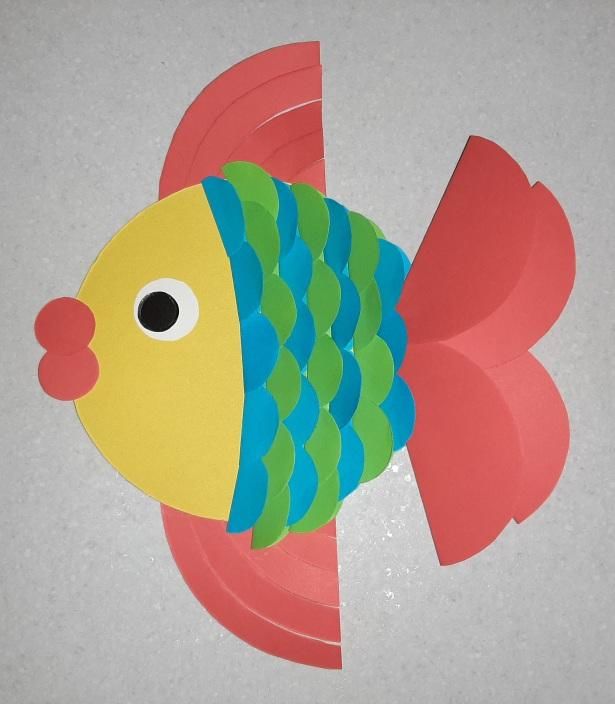
You can add seaweed to the background by cutting strips of different lengths in green shades. It will be great to draw something using bright markers.
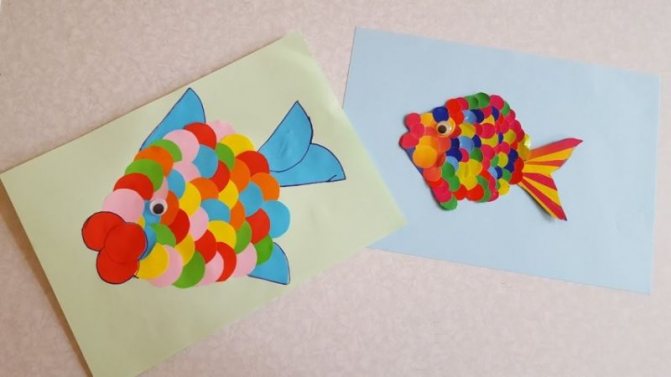
Application using origami technique
Older children (from older groups, for example) can try themselves by making an applique of a fish in an aquarium using the origami technique. There is a huge number of different schemes that are easy to find on the Internet.
They vary in degree of complexity, which means it is quite possible to choose something for yourself. Here is a simple option that your child can definitely repeat:
- Take a square of colored paper and make folds along both horizontal lines, as well as in half;
- Then unfold and fold so that the fold in the middle is inside a pair of triangles with a common vertex;
- Fold the corners from the sides of one of the triangles overlapping towards the middle. This will serve as a tail
All that remains is to turn the product over. You can decorate the fish however you like, the main thing is not to forget to draw an eye and a smiling mouth.
Fabric applique
For such a composition you will need fabric of different colors and templates according to which the parts will be cut out. Each part is cut out very carefully with scissors, because you need to work with such material very carefully.
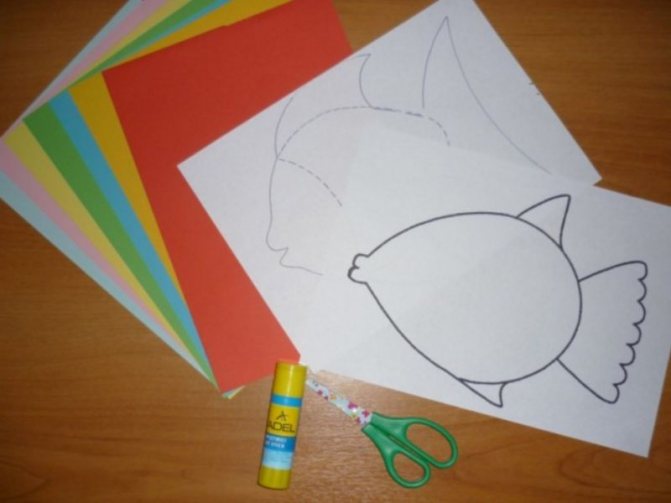
When all the elements are cut out, glue them as planned onto a cardboard sheet or fabric base.
To diversify the composition, it’s great to glue sequins, rhinestones, small beads and similar little things.
Simple craft for kids
You will need: models of circles from multi-colored double-sided sheets or candy wrappers, glue, a prepared fish template, made by yourself or printed on a printer from the Internet.
Children glue overlapping circles of different colors onto the workpiece (torso). Here the guys will be able to act not very carefully, which will not affect the quality of the application and their mood.
Volume applique
Despite the fact that the volumetric craft seems complicated, it is quite simple to make:
- Take a red or tan sheet of cardboard and draw a fish on it. Then cut it exactly along the contour. This is a blank for a future product;
- From double-sided paper in the colors you like, cut many narrow strips of the same size, and then glue the ends of each;
- All glued strips must be attached throughout the base, placing them evenly one after another. Only the head should remain free;
- Once the striping is complete, begin decorating the fish's head. Make a bunch of balls from scraps of napkins and paste them over the desired areas. The eyes and mouth are made in the same way.
This product looks quite unusual and unique.
Application from paper strips
This fish craft is no less beautiful and is perfect for kids. To construct one, you will need to cut out a blank that serves as a base from a sheet of multi-colored cardboard. One of them - a semicircle - is glued to the paper.
The remaining material must be cut into a bunch of thin strips. All of them are glued in half and then attached to the product blank. The second blank, which is a smaller semicircle, will become the fin. Eyes and other necessary details are drawn with a felt-tip pen.
After all the above steps have been completed, you can give free rein to your imagination and come up with something of your own, original. This way your fish will turn out to be even more interesting and will not be like any other.
Individual approach to each child
During preschool preparation, the educational process requires an individual approach. If one child is diligent, you should entrust him with cutting out elements from cardboard paper.
But entrust a real fidget with gluing the details of the composition. This way, the noisy child is involved in a group activity and will not get bored while cutting out appliqués for a long time.
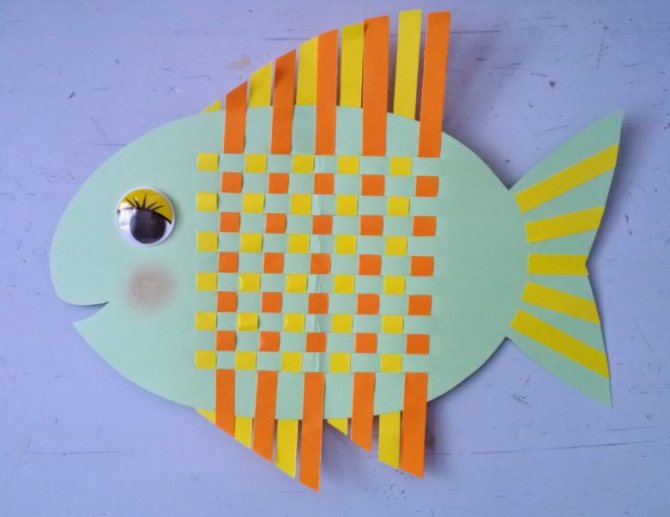
The formation of work fronts depends on several aspects:
- Temperament. Don’t push a slow baby by motivating him with the words “Everything has already been done!”
- Preparation. Not every child and their parents practice appliqué or other exciting activities at home. Therefore, not every child in the group will master certain tasks.
- Initiative. Don’t contradict your child if he wants to draw fish instead of the sea.
Accordion-shaped applique
This fish applique from colored paper is also easy to make yourself, and besides, the result will definitely please you. And to achieve it, you need to do the following:
- Take a regular rectangular piece of paper and fold it in half. Then, along the fold line, carefully cut it into a pair of identical parts;
- Fold the resulting part like an accordion, but do not go all the way to the end. Carefully trim off any remaining excess edges;
- Now that the most basic things have been done, you can make the remaining necessary parts from paper of different colors. Therefore, cut out the mouth, eyes, tail, and fins.
All that remains is to glue all the parts together, and then decorate the craft by painting it with felt-tip pens.
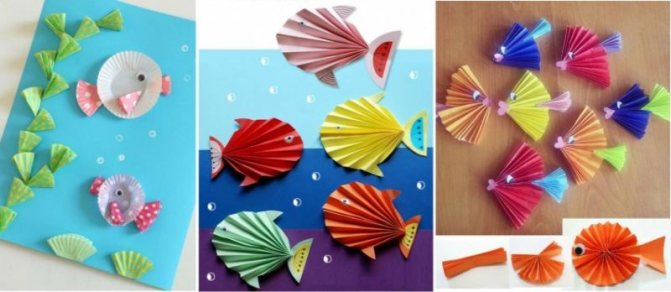
Nuances in the technique
A kindergarten teacher is like a conductor. Selects a program, knows the musicians' parts, and reworks the score. Skillfully leads the entire orchestra so that the piece sounds harmonious.
The situation is similar with children: the teacher plans application topics; selects materials; draws up a lesson plan.
The end result is a vernissage for parents. All the kids are busy with collective creativity. So, let's look at each point step by step.
Plasticine fish
Probably everyone will like this method because of its simplicity and fun. And the end result will be a delicious goldfish. To create this underwater inhabitant you need:
- Make a base for a future application. To do this, use yellow and red plasticine;
- Next, you will need to roll out many small balls and flatten them into circles;
- The plasticine that you will have left after completing the previous steps will need to be rolled out into narrow strips;
- Next, you need to take a blue cardboard piece and mark the silhouette of a fish on it, after which you should surround its outline with circles of red shades;
- The inside of the body itself is surrounded by yellow circles. And the tail and fins are lined with thin stripes;
- An eye is also made from plasticine, which is then attached to the required location.
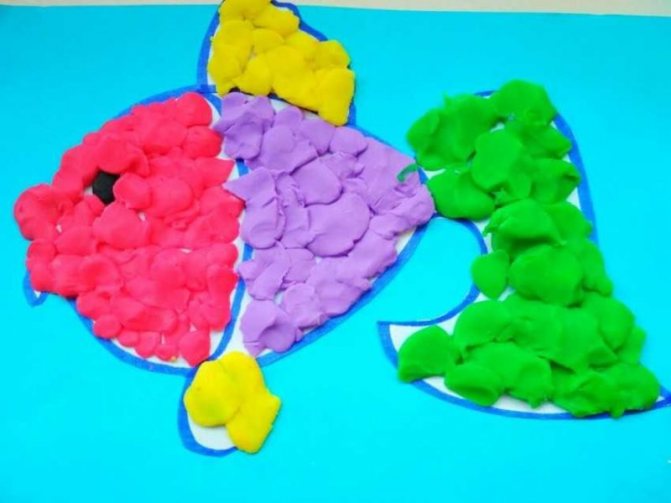
Once everything is ready, start decorating the background. Make seaweed, rocks, shells and other desired items from plasticine to complete the fish applique. Small pebbles or shells can be taken, even real ones, if such, of course, are available.
Use all your imagination, think through the whole composition. This way the product will look even more interesting and original. Once all the work is completed, you can place the craft in a prominent place so that it adds uniqueness to the overall atmosphere of the house and pleases the eye at any time.
About motivation
There is one famous saying: “Whatever you call a ship, that’s how it will sail.” Children's motivation works in a similar way. The way you motivate a child is how he works.
In this case, several methods of effective motivation are used.
- Conversation. An effective method to set up for productive activities. For example, ask some leading questions: Where do the fish live? Where will we place them - at home or in a group? Speak to children on behalf of animals by putting a doll of some animal on your hand.
- Puzzles. They intrigue and develop their way of thinking.
- Images. Children need a clear example to understand. So that your child can make a fish, show a photo of the fish applique.
- Presentation. Show a short slide video while talking about the underwater world.
- Stories. Talk about a goldfish to encourage kids to create a similar prototype. This is a great way to boost their motivation levels.
Applications from other materials
If desired, you can use any available material. If you take something not quite ordinary, the product will turn out much more interesting. Here are some examples of simple crafts made from a variety of materials.
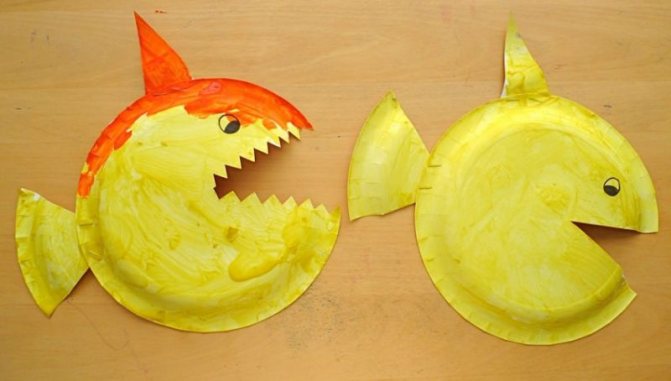
From leaves
Crafts made from autumn leaves are quite popular and loved. This is because the colorful leaves themselves are beautiful, and when they are folded into a certain composition, they become even more beautiful.
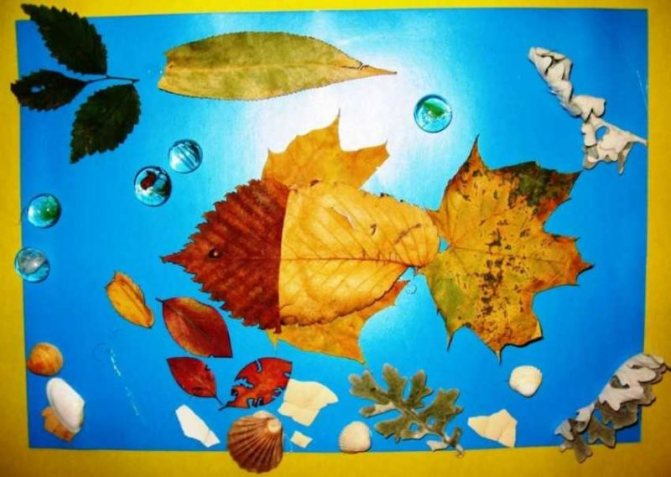
Such products add coziness when they serve as decoration in the home, and also bring a lot of positive emotions and give a good mood. In addition, anyone can handle this craft, as it is not at all difficult to create.
In order to make such an applique, you will need colorful autumn leaves. Before work, you will need to prepare them - rinse them under a weak stream of water, dry them and put them in a thick book so that they dry and straighten.
If you don’t have time to wait for the leaves to dry and straighten out in the book, you can dry them using an iron.
The basis is a piece of cardboard of any color you like, onto which a large orange leaf is attached. This will be the body of the fish. Other leaves, colored red, will become fins and a tail.
After completing the craft, decorate it with various twigs and other natural materials. You need to add algae and other seabed objects to the background.
From seeds, cereals, or pasta
Making fish from seeds is not at all difficult. You just need to follow these steps:
- Select a piece of cardboard of any shade and draw the outline of the future fish on it;
- Take glue and generously coat the entire area inside the outline;
- Now you can stick seeds, cereals, or pasta onto the glue, thereby building the fish itself. It is important to do this carefully so that the product turns out neat and tidy;
- After this, attach an eye made of paper or plasticine. Fins and tail can also be cut out of colored paper of any color.
This application is very interesting and will probably appeal to many children due to its unusual nature.
From buttons
You can make such a figurine yourself using ordinary buttons. You will need a template that is easy to find on the Internet, or you can draw it yourself.
It is painted in any color you like, and then buttons are selected to match it. Then, very evenly and carefully, each of them is glued to the base. This creates a voluminous and wonderful figure. And the remaining buttons are suitable for decoration.
Now that you have learned about so many ways to make your own fish, you can try each of them with your little one. Both he and you will enjoy spending time together doing such an exciting, useful and fun activity.
